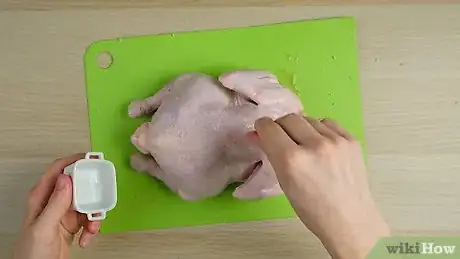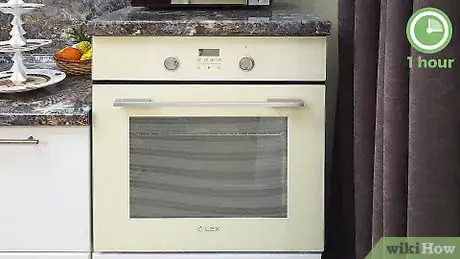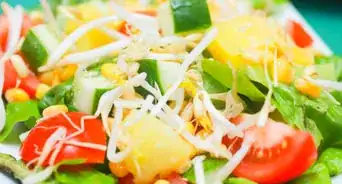This article was co-authored by JoAnna Minneci and by wikiHow staff writer, Jessica Gibson. JoAnna Minneci is a Professional Chef based in the Nashville, Tennessee area. With more than 18 years of experience, Chef JoAnna specializes in teaching others how to cook through private cooking lessons, team-building events, and wellness and nutrition classes. She has also appeared in numerous television shows on networks such as Bravo and Food Network. Chef JoAnna received Culinary Arts training from the Art Institute of California at Los Angeles. She is also certified in sanitation, nutrition, kitchen management, and cost control.
There are 9 references cited in this article, which can be found at the bottom of the page.
This article has been viewed 474,193 times.
A perfectly roasted chicken can be one of the most comforting or elegant meals you make. Unfortunately, many people are frustrated by roasted chicken with soggy skin, dry meat, or burnt spots. To prevent these from happening to your bird, keep things simple. Season a completely dry chicken with salt and cook it at high heat so the skin crisps up. Once you've mastered a classic roast chicken, spice things up by trying a few variations.
Ingredients
- 3 1⁄2 to 4 lb (1.6 to 1.8 kg) whole chicken
- Kosher salt for seasoning
- 1 tablespoon (15 ml) of olive oil
Makes 1 roasted chicken
Steps
Making Simple Roasted Chicken
-
1Season the chicken with 1/2 teaspoon (2 g) of kosher salt per 1 pound (450 g). Remove the chicken from its packaging and take any giblets out of the cavity. Then, set the chicken on a platter and sprinkle the entire surface with kosher salt. Use 1/2 teaspoon (1 g) for every 1 pound (450 g). Refrigerate the uncovered chicken for up to 1 day.[1]
- This may seem like a lot of salt, but it will get into the meat and flavor the chicken.
- Discard the giblets or save them for another recipe.
Tip: Look for an organic or free-range chicken since these usually have the best flavor and texture.
-
2Preheat the oven to 425 °F (218 °C) and set the chicken on the counter. Let the chicken sit out for at least 30 minutes so it comes closer to room temperature. This will help the chicken cook evenly and prevent the skin from browning before the center finishes roasting.[2]
- If you like the chicken to have extra-crispy skin, place a cast-iron skillet or roasting dish into the oven while it's preheating.
Advertisement -
3Pat the chicken dry and drizzle 1 tablespoon (15 ml) of olive oil in a skillet. Take a paper towel and blot any moisture from the surface of the chicken. If you pre-heated the skillet or roasting pan, carefully take it out of the oven and set it on the stove. Drizzle the olive oil into the bottom of the skillet and swirl it a little.[3]
- The olive oil will prevent the chicken skin from sticking to the skillet.
- If you'd like to keep the chicken legs together as they roast, wrap them together with a piece of kitchen twine.
-
4Put the chicken into the skillet and place it in the preheated oven. Set the chicken into the skillet so the breasts are facing up and put the skillet on the center rack near the back of the oven. Position the bird so the legs are pointing towards the back corner.[4]
- The back corner is one of the hottest parts of the oven. Since the legs take longer to cook than the breasts, positioning the chicken this way will prevent the breast meat from drying out.
-
5Roast the chicken until it reaches 165 °F (74 °C). Set a timer for about 1 hour and leave the chicken to cook without turning or basting it. You'll hear it sizzle as it cooks and it should become golden brown. To test if it's finished, insert an instant-read meat thermometer into the thickest part of the thigh. If it hasn't reached 165 °F (74 °C), check it again in a few minutes.
- Keep in mind that it will take longer for a heavier bird to cook than one that doesn't weigh as much. If you're using a 3 lb (1.4 kg) chicken, you may want to check it after only 50 minutes.[5]
-
6Remove the skillet and transfer the chicken to a cutting board. Turn off the oven and wear oven mitts to take the skillet out. Use caution when you set the skillet on the stove and transfer the chicken to a cutting board since it will be sizzling.[6]
- If you roasted vegetables in the skillet with the chicken, scoop them out and put them on a serving plate.
-
7Rest the chicken for 15 to 20 minutes before you carve it. Leave the chicken on the cutting board so the juices redistribute within the meat. Resting the chicken will also make it easier to carve since you won't accidentally burn yourself.[7]
- You can use the pan drippings to make gravy while the chicken is resting.
- Store leftover roasted chicken in an airtight container for up to 3 to 4 days.
Tip: For amazing croutons, toss 2 in (5.1 cm) chunks of bread in the drippings and return the skillet to the hot oven for 2 to 3 minutes. They'll crisp up and you can serve them with the chicken or a green salad.
Trying Variations
-
1Marinate the chicken in buttermilk overnight to get extra-tender meat. Place your salted chicken into a sealable plastic bag and pour in 2 cups (470 ml) of buttermilk. Press the air out and seal the bag shut before you turn the bag over to coat the chicken. Then, refrigerate the buttermilk chicken for up to 1 full day before you roast it.[8]
- Discard the buttermilk once you've lifted the chicken out of the bag.
Did You Know? The buttermilk will also help the chicken become golden brown on the outside.
-
2Cover the chicken in a spice rub before roasting it. Raid your spice cabinet for unique seasoning rubs or create your own. Sprinkle the entire surface of the chicken and use your fingers to gently massage the spices into the skin. Consider using one of these spice rubs:[9]
- Za'atar
- Garam masala
- Chili powder with paprika
- Creole seasoning
- Jerk seasoning
- Lemon pepper
-
3Fill the cavity of the chicken with onions, garlic, herbs, or citrus. Although simply salted chicken will be moist and tasty, you can easily add flavor by putting a halved lemon or orange into the center of the bird. Try roasting a chicken with a quartered onion or a head of garlic stuffed inside. If you enjoy herbs, place a few sprigs in as well.[10]
- Experiment with different aromatic combinations. For example, try orange-ginger chicken, tarragon-lemon chicken, or rosemary-garlic chicken.
-
4Add sliced vegetables to the skillet to make a complete meal. If you'd like your whole meal to cook at the same time with very little effort, cut potatoes into 1⁄4 inch (0.64 cm) thick pieces and arrange them around the chicken in the skillet or roasting dish. You could also slice or chop these vegetables:[11]
-
5Roast the chicken in a slow cooker for a hands-off meal. Place your seasoned chicken into a slow cooker so the breasts are facing up. Put the lid on and cook the chicken on 'Low' for 4 to 5 hours or on 'High' for 2 1/2 to 3 1/2 hours.[12]
- Remember that you can scatter chopped vegetables, such as onions, potatoes, and carrots, around the chicken.
Community Q&A
-
QuestionWhat is the purpose of the lemon?
 Community AnswerIt steams inside the cavity, keeping the meat moist as it cooks, and it imparts some citrus flavor.
Community AnswerIt steams inside the cavity, keeping the meat moist as it cooks, and it imparts some citrus flavor. -
QuestionIs it better to roast breast side up or down?
 Community AnswerRoast it breast side up.
Community AnswerRoast it breast side up. -
QuestionIs it possible to roast a chicken without a lemon?
 Community AnswerYes, I do mine by inserting an onion instead of the lemon, but you don’t have to use anything.
Community AnswerYes, I do mine by inserting an onion instead of the lemon, but you don’t have to use anything.
Things You'll Need
- Measuring spoon
- Skillet or roasting dish
- Oven mitts
- Paper towels
- Instant-read meat thermometer
- Knife and cutting board
- Serving platter
References
- ↑ https://www.bonappetit.com/recipe/cast-iron-roast-chicken-with-crispy-potatoes
- ↑ https://youtu.be/b-pq7MA2ko4?t=67
- ↑ https://www.bonappetit.com/story/roast-chicken-season
- ↑ https://www.friendsofthefarms.org/blog/2019/2/8/buttermilk-marinated-roast-chicken
- ↑ https://www.bonappetit.com/recipe/cast-iron-roast-chicken-with-crispy-potatoes
- ↑ https://www.bonappetit.com/recipe/cast-iron-roast-chicken-with-crispy-potatoes
- ↑ https://www.bonappetit.com/story/roast-chicken-season
- ↑ https://youtu.be/b-pq7MA2ko4?t=19
- ↑ https://www.epicurious.com/recipes-menus/spice-blends-dry-rubs-and-other-seasoning-mixes-gallery
About This Article
While perfectly roasting a chicken may seem difficult, it’s actually relatively simple. Start by seasoning your chicken with ½ teaspoon of kosher salt per pound of meat. Once you’ve seasoned your chicken, let it rest at room temperature for at least 30 minutes to help it cook evenly. Pat the chicken dry to remove any excess moisture and drizzle 1 tablespoon of oil in a skillet or roasting pan. Put the chicken into the skillet and put it in an oven preheated to 425 degrees Fahrenheit. Bake it for 1 hour. To test if it’s done, put a meat thermometer into the thickest part of the thigh. Your chicken is done when it reaches 165 degrees Fahrenheit. Rest the chicken for 15 to 20 minutes before carving it so the juices redistribute into the meat. To learn how to marinate your roasted chicken, keep reading!




















































